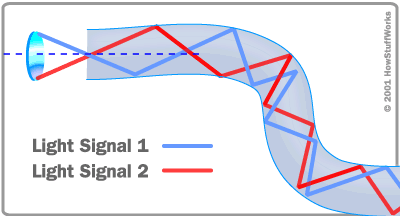Fiber Optics
I mentioned before how we could use our understanding of Snellís Law to create fascinating devices, but this is my personal favorite. Transmitting data long distance can be tricky. Copper is a generally a pretty good conductor, and by that I mean it has very little resistance and doesnít heat up too much when changed. The problem is it stops being as useful when used over a long distance. The amount of energy it takes to send a signal across an ocean on a copper wire can be staggering, and while it has low resistance, the signal speed is highly dependent on the voltage used to power it, meaning your signal will either be slow or expensive.

From: HowStuffWorks, Inc
An optical fiber line on
the other hand, is a different beast. It uses three
layers of material to send signals. The core is a dense,
clear material that the signal (light!) travels through.
Outside that is a layer of less-dense material. When the
light in the core hits the outer layer, it is at such
passed the critical angle, so it reflects back towards
the core. This ensures that the signal will move at
almost the speed of light at any distance. The last
layer is a shield to prevent light entering the system
and causing corruption. This cable is cheaper to produce
and maintain, faster, and more reliable than copper
wire.